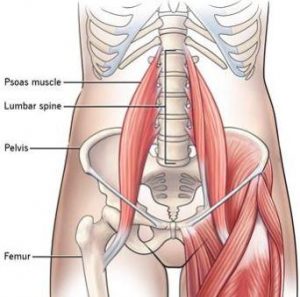Restore: The Core program
Level 3
Hurdle Holds
The Hurdle Hold exercise (strange name – important exercise!) brings about a little different focus in our core stability and strength training. We’re getting into the hip girdle a bit more for starters!
Additionally, with the use of the mini band that you’ll need for this exercise, we’re increasing the load! This is Level 3 after all!😊
So what’s the reason for a slight shift in focus?
Hurdle Holds zero in on an often misunderstood and subsequently, poorly trained group of muscles: the psoas complex (psoas major and minor). (You’ll see increasing focus on the hip girdle in another of the exercises in Level 3, Swiss Ball Bridging and Curls).
 So, here’s the deal:
So, here’s the deal:
Typically the psoas group is thought of as a muscle group whose primary function is to flex the hip.
However, what we’ve learned in the relatively recent past through scientific research and a better understanding of human function, is that the psoas group is synergistically related to several other muscles of the trunk, spine, pelvis and hip girdle.
Take a look at the image to the left. Notice how the psoas is attached to BOTH the lumbar spine (your low-back) and the thigh bone (also known as the femur).
There are also distinct fascial connections to the pelvis, diaphragm, and pelvic floor.
The bottom line here is that this particular muscle and others around the middle of our body function as important contributors to core stability. They’re all part of the big picture with regard to core stability.
So, what’s the problem?
They’re usually trained the WRONG way with poorly designed and potentially damaging sit-ups, crunches, and the like.
DON’T do those! 😊
How is this different?
With this exercise, your focus is on maintaining that neutral low back posture and alignment, so that you avoid overusing back muscles.
Your goal is to train the psoas in the presence of good alignment first and foremost, actively engaging the anterior core and deeper muscles (such as psoas) to help stabilize the lumbar spine appropriately.
-
Focus on proper alignment and maintain a neutral low-back position. Use your hands to assist!
-
Keep your low ab engaged throughout. This takes focus.
-
Follow the directions in the video to progress appropriately.
-
Form and quality are everything.
How often should you do this?
Hurdle Holds are definitely muscularly fatiguing. You’ll need rest between training sessions. Refer to the Scheduling portion of this program for specific guidance. A general rule of thumb? 5 to 10 repetitions each side (at the level of strength you’re at right now), 2x per week, should do it.
Focus on quality, not quantity. Train smart.
